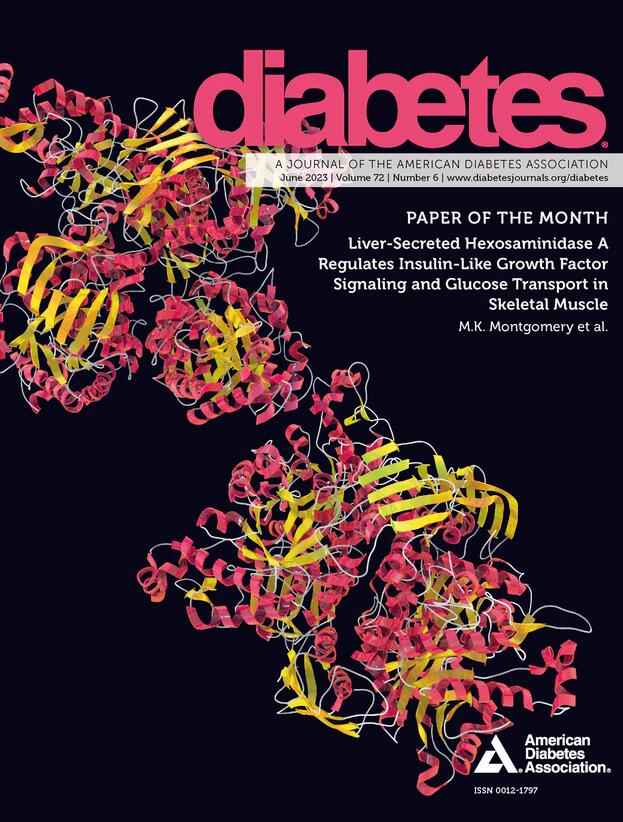161-OR: Prediabetes Remission and Cardiovascular Mortality and Morbidity
IF 6.2
1区 医学
Q1 ENDOCRINOLOGY & METABOLISM
引用次数: 0
Abstract
Introduction and Objective: Lifestyle interventions (LI) are effective in preventing T2D in people with prediabetes. Whether this approach also reduces cardiovascular (CV) death and heart failure (CHF) in people with prediabetes is matter of debate. We tested the hypothesis whether remission of prediabetes to normal glucose regulation (NGR; FPG<5.6 mmol/l, 2-h glucose OGTT <7.8 mmol/l, HbA1c <39 mmol/mol) reduces CV complications in people with prediabetes. Methods: In the Diabetes Prevention Program Outcomes Study (DPPOS) Phase 3 from the NIDDK repository from all three treatment arms (LI, metformin, placebo) with data for up to 21 years of follow-up were analyzed. Participants were separated into responders (i.e. remission to NGR) and non-responders (non-remission to NGR) based on the response at year 1 of the DPP intervention. Outcomes included 1) a composite of CV death and hospitalization for CHF and 2) extended MACE (CV events/death, arterial revascularization, hosp. for CHF or unstable angina, diagnosis of coronary heart disease or silent myocardial infarction). Results: Of 2427 participants, 278 (11%) were responders and 2149 (89%) non-responders at year 1. At baseline, BMI was 32.3kg/m2 (IQR: 28.7, 37.0) in responders and 32.5Kg/m2 (28.8, 37.1) in non-responders, and was reduced to 30.1kg/m2 (26.6, 34.2) and 31.4kg/m2 (27.7, 36.2; both p<0.01), respectively. In total, 93 of 278 (33.5 %) responders were diagnosed with T2D during DPPOS phase 3 compared to 1215 of 2149 (56.5 %) non-responders (p<0.001). During a mean observation time of 21 years and after adjustment for available risk factors, including baseline body weight, age, development of T2D, randomization assignment and medication, responders had lower relative risk (RR) for the composite endpoint of CV death and CHF (RR=0.43 (95 % CI: 0.21, 0.90); p=0.02) and for extended MACE (RR=0.60 (0.41, 0.89) p=0.01) than non-responders. Conclusion: LI-induced prediabetes remission markedly reduced CV morbidity and mortality in people with prediabetes. Disclosure E. Vazquez Arreola: None. R.L. Hanson: None. A. Sandforth: None. L. Sandforth: None. S. Katzenstein: None. N. Stefan: Speaker's Bureau; AstraZeneca, Boehringer-Ingelheim. Consultant; Lilly Diabetes. Speaker's Bureau; Lilly Diabetes. Consultant; Pfizer Inc. Speaker's Bureau; Sanofi. Research Support; Sanofi. Speaker's Bureau; Novo Nordisk, GlaxoSmithKline plc. Consultant; GlaxoSmithKline plc. H. Preissl: None. N. Marx: Speaker's Bureau; Abbott, Amgen Inc, AstraZeneca. Advisory Panel; AstraZeneca. Speaker's Bureau; Bayer Pharmaceuticals, Inc. Advisory Panel; Bayer Pharmaceuticals, Inc. Speaker's Bureau; Boehringer-Ingelheim. Advisory Panel; Boehringer-Ingelheim. Speaker's Bureau; Daiichi Sankyo. Advisory Panel; Merck Sharp & Dohme Corp. Speaker's Bureau; Novo Nordisk. Advisory Panel; Novo Nordisk. Speaker's Bureau; Sanofi. Advisory Panel; Sanofi. Speaker's Bureau; Lilly Diabetes. R. Jumpertz von Schwartzenberg: None. A.L. Birkenfeld: None. Funding Intramural Research Program of the National Institute of Diabetes and Digestive and Kidney Diseases (NIDDK). German Federal Ministry for Education and Research (01GI0925) via the German Center for Diabetes Research (DZD e.V.)161-OR:糖尿病前期缓解与心血管死亡率和发病率
前言和目的:生活方式干预(LI)可有效预防糖尿病前期患者的T2D。这种方法是否也能降低糖尿病前期患者的心血管(CV)死亡和心力衰竭(CHF)仍有争议。我们检验了糖尿病前期缓解到正常血糖调节(NGR;5.6 mmol/l, 2小时葡萄糖(OGTT) 7.8 mmol/l,糖化血红蛋白(HbA1c) 39 mmol/mol)可减少糖尿病前期患者的心血管并发症。方法:在糖尿病预防项目结局研究(DPPOS)中,来自NIDDK存储库的所有三个治疗组(LI,二甲双胍,安慰剂)的3期数据进行了长达21年的随访分析。根据DPP干预第1年的反应,将参与者分为有反应者(即NGR缓解)和无反应者(NGR未缓解)。结果包括:1)心血管死亡和CHF住院的复合;2)延长MACE(心血管事件/死亡、动脉血运重建术、CHF或不稳定心绞痛住院、冠心病或无症状心肌梗死的诊断)。结果:在2427名参与者中,第一年有278名(11%)缓解,2149名(89%)无缓解。基线时,有反应者的BMI为32.3kg/m2 (IQR: 28.7, 37.0),无反应者的BMI为32.5Kg/m2(28.8, 37.1),降至30.1kg/m2(26.6, 34.2)和31.4kg/m2 (27.7, 36.2);p<0.01)。总的来说,278名应答者中有93名(33.5%)在DPPOS 3期被诊断为T2D,而2149名无应答者中有1215名(56.5%)被诊断为T2D (p<0.001)。在平均21年的观察时间内,在调整了包括基线体重、年龄、T2D的发展、随机分配和药物在内的现有危险因素后,应答者在CV死亡和CHF复合终点的相对风险(RR)较低(RR=0.43 (95% CI: 0.21, 0.90);p=0.02)和延长MACE (RR=0.60 (0.41, 0.89) p=0.01)均优于无反应者。结论:锂诱导的前驱糖尿病缓解显著降低了前驱糖尿病患者的CV发病率和死亡率。E.巴斯克斯·阿雷奥拉:没有。R.L. Hanson:没有。A.桑德福斯:没有。L.桑德福斯:没有。卡岑斯坦:没有。N. Stefan:发言人局;阿斯利康,勃林格殷格翰的发言。顾问;莉莉糖尿病。演讲者的局;莉莉糖尿病。顾问;辉瑞公司演讲者的局;赛诺菲。研究支持;赛诺菲。演讲者的局;诺和诺德,葛兰素史克公司。顾问;葛兰素史克。H. Preissl:没有。马克思:发言人局;雅培,安进公司,阿斯利康。顾问小组;阿斯利康。演讲者的局;拜耳制药公司顾问小组;拜耳制药公司演讲者的局;勃林格殷格翰集团。顾问小组;勃林格殷格翰集团。演讲者的局;第一三共制药。顾问小组;默克夏普公司;Dohme公司发言人局;诺和诺德公司。顾问小组;诺和诺德公司。演讲者的局;赛诺菲。顾问小组;赛诺菲。演讲者的局;莉莉糖尿病。R. Jumpertz von schwartzberg:没有。A.L. Birkenfeld:没有。资助国家糖尿病、消化和肾脏疾病研究所(NIDDK)的校内研究计划。德国联邦教育和研究部(01GI0925)通过德国糖尿病研究中心(DZD e.v.)
本文章由计算机程序翻译,如有差异,请以英文原文为准。
求助全文
约1分钟内获得全文
求助全文
来源期刊

Diabetes
医学-内分泌学与代谢
CiteScore
12.50
自引率
2.60%
发文量
1968
审稿时长
1 months
期刊介绍:
Diabetes is a scientific journal that publishes original research exploring the physiological and pathophysiological aspects of diabetes mellitus. We encourage submissions of manuscripts pertaining to laboratory, animal, or human research, covering a wide range of topics. Our primary focus is on investigative reports investigating various aspects such as the development and progression of diabetes, along with its associated complications. We also welcome studies delving into normal and pathological pancreatic islet function and intermediary metabolism, as well as exploring the mechanisms of drug and hormone action from a pharmacological perspective. Additionally, we encourage submissions that delve into the biochemical and molecular aspects of both normal and abnormal biological processes.
However, it is important to note that we do not publish studies relating to diabetes education or the application of accepted therapeutic and diagnostic approaches to patients with diabetes mellitus. Our aim is to provide a platform for research that contributes to advancing our understanding of the underlying mechanisms and processes of diabetes.
 求助内容:
求助内容: 应助结果提醒方式:
应助结果提醒方式:


